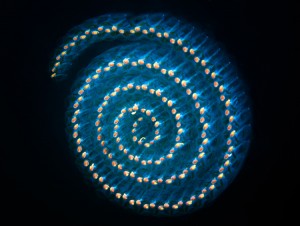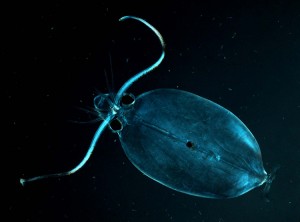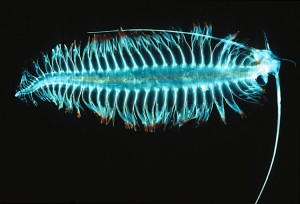Undersea Light Deception
Friday, August 11th, 2017August 11, 2017
In order to survive, many animals have undergone some incredibly unique adaptations. The ability to change colors is fairly common in the animal world, as is the development of dazzling or dull colors for camouflage. But a rare few critters use light itself to deceive or even not to be seen at all. In the dark depths of the oceans, the smallest traces of light can illuminate a hungry fish’s potential dinner. For the hunted, then, it is better not to reflect light at all, and become nearly invisible, or to create or bend light so as to appear as something else.

Glowing sea salps live most of their lives together in deep-sea colonies. To predators, the illuminated salp chains appear to be much larger (and less edible) animals. Gelatinous, usually-transparent salps are often mistaken for “jellyfish eggs” when wind and sea currents drive them onto beaches. Credit: © Kondratuk Aleksei, Shutterstock
Most light deceivers and transparent animals live in pelagic zones of the world’s oceans. Pelagic zones are open ocean areas far from land. There, the oceans are often the deepest, and there live some of the planet’s most unusual forms of life. If we travel deep into the pelagic zones, we might be lucky enough to encounter some of these hard-to-spot animals. To better understand them, let’s look at how some of these animals achieve their unique levels of light-bending talent.
The glass octopus is fairly see-through. However, its eyes are almost always visible. But it has a trick! The glass octopus camouflages its eyes by using objects that work as mirrors. These “mirrors” in the open ocean reflect only more ocean and so make the eyes unnoticeable to predators. So with a quick turn, the glass octopus becomes “invisible.”

The glass squid, about 4 inches (10 centimeters) across, uses transparency and light-creating abilities to hide from predators. Credit: Edie Widder, NOAA
The transparent glass squid uses photophores (light-producing organs) in a process called counter-illumination. In this method of camouflage, the animal produces light that flickers and wavers, creating an illusion of sunlight filtering down from the ocean surface. A predator beneath the glass squid will look up at the squid but see only “sunlight.” For predators above or to the side of the glass squid, however, counter-illumination can create unwanted curiosity. Best for the glass squid to stay on top of things, then.
Tomopteris deep-sea worms (a type of plankton) also produce light to hide from predators. The worm bends its own light as it moves, creating an ever-changing appearance from all angles. It shines brightly one second, and then it disappears with a wiggle. To completely throw the predator off track, the worm can also release glowing parts of its body called parapodia. The predator then goes after the illuminated ejected bait instead of the main body of the clever tomopteris worms.

Tomopteris worms create and bend light to deceive predators. Credit: Uwe Kils (licensed under CC BY-SA 3.0)
Some hyperiids, tiny crustaceans related to both fleas and shrimp, are covered in infinitesimal (extremely small) bumps or spheres, as well as tiny hairs. These tiny features minimize light scattering, which greatly reduces the hyperiid’s reflectance. Scientists are still learning about these rare animals, however, and some think the tiny bumps may actually be bacteria. That possibility is interesting, too, because it would be a remarkable instance of symbiosis (unlike organisms living together for mutual benefit).
A species of squid (Japetella heathi) and a species of octopus (Onychoteuthis banksii) can quickly go from transparent to a reddish-brown color. Cells in their body, called chromatophores, contain a dye. When they detect light, the animals immediately expand and release the dye, effectively appearing out of nowhere.
Sea sapphires are tiny crustaceans the size of ants. To become nearly invisible, they employ tiny crystal plates in a hexagonal honeycomb pattern. The crystals are separated by a souplike fluid called cytosol. Sea sapphires can emit a wide range of vivid colors from blue to red to gold. The thicker the layer of cytosol, the longer the wavelength that is being reflected. (Red has the longest visible wavelength, violet the shortest.) When light hits a sea sapphire at a certain angle, its light reflectance can even shift into the ultraviolet (beyond the visible part of the color spectrum). This allows the sea sapphire to “vanish into thin water.”



